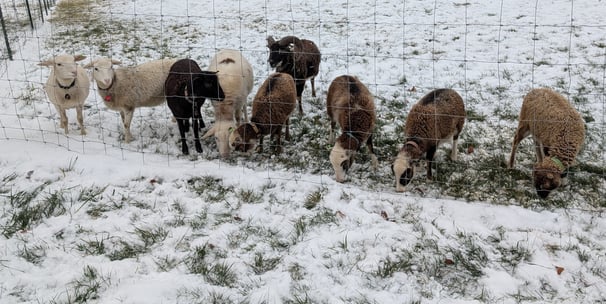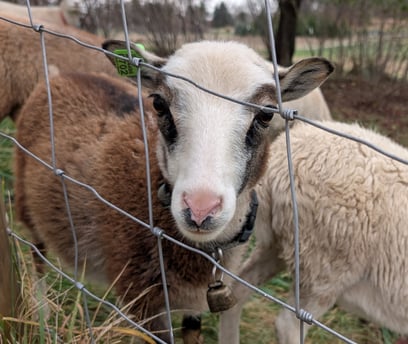Biosecurity
Biosecurity means taking steps to protect your flock from infectious diseases, pests, and other health risks. It involves preventing disease-causing agents from entering your farm and stopping their spread if they do get in. Good biosecurity is a crucial investment, regardless of flock size, as it protects your animals' health, your financial investment, and even human health (since some diseases can pass from sheep to people). (MU Extension, n.d.; American Sheep Industry Association, n.d.).


Why is Biosecurity Important?
Many sheep diseases can cause significant economic losses and serious animal welfare issues. Some key concerns include:
Foot Rot & CODD: Highly contagious lameness issues.
Caseous Lymphadenitis (CL): Causes abscesses (internal/external).
Ovine Progressive Pneumonia (OPP): A slow, fatal viral disease.
Johne's Disease: A chronic, fatal wasting disease.
Scrapie: A fatal neurological disease (part of mandatory eradication programs).
Contagious Abortion: Diseases like Enzootic Abortion, Vibrio, and Toxoplasmosis.
Parasites: Both internal (worms, coccidia) and external (scab, lice, keds) can be brought in.
How Does Disease Spread?
Understanding how pathogens travel is key to stopping them. Common pathways include:
New Animals: This is the number one risk. Sheep can look healthy but carry diseases.
Visitors: People can carry pathogens on boots, clothing, and hands.
Vehicles & Equipment: Trucks, trailers, tractors, handling equipment, and even shearing gear can carry mud, manure, and microbes from one farm to another.
Other Animals: Wildlife, rodents, birds, dogs, and cats can carry or spread diseases (e.g., cats and Toxoplasmosis).
Feed & Water: Contaminated feed or water sources.
Airborne Spread: Less common for many sheep diseases but possible, especially with respiratory issues in close confinement.


Building Your Biosecurity Plan: Key Steps
A good plan involves multiple layers of protection. Work with your veterinarian to tailor a plan specific to your farm.
1. Managing New Animals (Quarantine is CRITICAL!)
Aim for a Closed Flock (If Possible): The safest flock is one where no new animals are introduced. If you must buy replacements, limit your sources.
Buy Smart: Purchase animals from reputable flocks with known health histories and testing programs. Avoid sale barns if possible, as animals there have unknown backgrounds and exposure (MU Extension, n.d.).
Isolate & Quarantine: All new animals (including rams) and any of your own animals returning from shows or sales must be quarantined.
Duration: A minimum of 30 days is essential; 60 days is even better (MU Extension, n.d.; Farmers Weekly, 2024).
Location: Keep them in a completely separate area. This means no fence-line contact (ideally double-fenced with at least 6-10 feet between) and no shared air space (separate building if possible).
Management: Always feed, water, and handle quarantined animals last, after caring for your main flock. Use separate tools, buckets, and clothing/boots, or thoroughly clean and disinfect everything before moving back to your main flock (Iowa State University, n.d.).
During Quarantine:
Observe: Watch closely daily for any signs of illness (coughing, lameness, diarrhea, abscesses, etc.).
Test: Work with your vet to test for key diseases like OPP, CL, and Johne's.
Vaccinate: Update their vaccinations to match your flock's protocol.
Treat Parasites: Deworm with effective drugs (potentially multiple classes – consult your vet) and treat for external parasites (like dipping for scab) (Farmers Weekly, 2024). Keep them off pasture for 48 hours after deworming, then turn them out onto a recently grazed (contaminated) pasture within the quarantine area to help dilute any resistant worms they might shed.
Inspect Feet: Check and trim hooves, looking for any signs of foot rot.
2. Visitor & Vehicle Management
Limit Access: Not everyone needs to enter your pastures or barns. Have a designated meeting area. Use signs to direct visitors and state your biosecurity rules (Business Queensland, n.d.).
Parking: Designate a parking area away from animal areas and traffic patterns.
Clean In, Clean Out: Require visitors to have clean boots and clothing. Provide disposable boot covers or a foot bath (ensure the foot bath is kept clean and charged with fresh disinfectant, and boots are cleaned of all organic matter before dipping).
Log Book: Keep a record of all visitors – who they are, when they visited, and if they have had recent livestock contact.
Farm Vehicles: Use your own vehicle to transport visitors around the farm whenever possible (Business Queensland, n.d.). Clean and disinfect any delivery or service vehicles that must enter animal areas.
3. Equipment & Tools
Don't Share (If Possible): Avoid sharing equipment. If you must borrow or share, it must be thoroughly Cleaned & Disinfected (C&D) before it comes onto your farm and before it leaves.
Cleaning & Disinfection (C&D): This is a two-step process:
Clean: Remove all visible organic matter (mud, manure, bedding) using brushes, scrapers, and high-pressure water/detergent (APHIS, n.d.). Disinfectants do not work effectively on dirty surfaces (Ohioline, n.d.).
Disinfect: Apply an appropriate disinfectant (approved for farm use, effective against relevant pathogens) according to label directions (contact time, concentration). Allow surfaces to dry completely.
Shearing: Ensure shearers use strict C&D protocols between flocks and ideally between animals if issues like CL are present (WSU Extension, n.d.).
4. Feed, Water & Environment
Protect Feed: Store feed securely to prevent contamination by rodents, birds, and other animals.
Water Sources: Protect water sources from manure runoff and wildlife access. Keep troughs clean.
Manure Management: Handle manure in a way that prevents spreading disease (e.g., composting before spreading on pastures).
Pest Control: Implement rodent and fly control programs.
Wildlife: Maintain strong fences to limit contact between your sheep and wildlife (especially deer).
Disposal: Remove and dispose of dead animals and afterbirths promptly and correctly according to local regulations.
Conclusion
Biosecurity isn't a one-time task; it's an ongoing mindset and set of practices. While it requires effort, a strong biosecurity plan is one of the best investments you can make in the long-term health, welfare, and profitability of your sheep flock.
